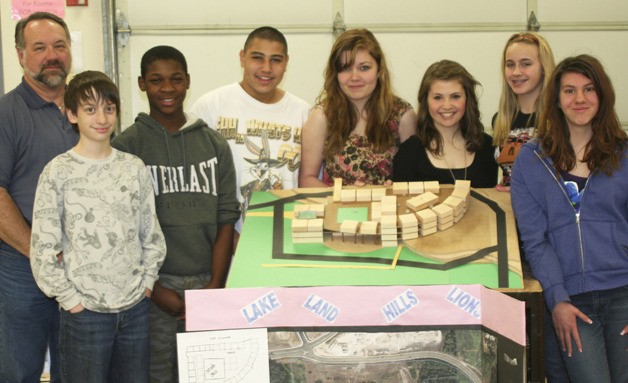A team from Mt. Baker Middle School students recently captured first place in the 2012 School of the Future Design Competition sponsored by the Council of Educational Facility Planners International.
The team – comprised of James Baldwin, Kylie Covara, Jordan Harrison, Conner Hofman, Adrian Hollingsworth, Madalyn Horine, Josh Leitner and Aislinn Suelflow – will represent the state at the Feb. 23 regional competition at NAC Architecture in Seattle.
The team designed, planned and created a prototype of a school for the future situated on a building site the Auburn School District owns for a building project.
“The students took off with the project. After a lot of research and investigation, the students created a final product that was structurally sound and environmentally conscious,” said Bruce Jacobs, Mt. Baker teacher and project adviser. “The building blends with the landscape and even utilizes the site’s wetlands for a ‘Science on Wheels’ curriculum.”
Jesse Kingsley, a University of Washington architecture graduate student, also mentored the team.
The schoolhouse boasts geothermal electricity, light tubes and skylights, pedestrian sky bridge, performing arts center, two-story gymnasium, green wall and rooftop garden.
The team designed a paved path from the schoolhouse to the wetlands and a footbridge into the wetlands so it can be accessed for hands-on, outdoor science education.
All classrooms follow a curvature along the southeast side of the building to maximize the use of natural lighting and to provide an unobstructed view of Mt. Rainier.
Additionally, the lower gymnasium, cafeteria, performing arts center and commons are located together to increase community engagement.
The team presented its project to a jury for review. Its visual aids included a 3-D model of the school, PowerPoint presentation, display board and site map.
The annual competition, open to middle school students, challenges student teams to design their schools to enhance learning, conserve resources, be environmentally responsive and engage the surrounding community. The opportunity allows students to develop math, science, language, communication and leadership skills through the process of design. The multi-disciplinary solution requires students to follow a planning process from the concept phase to completion of the project, with thorough documentation.


